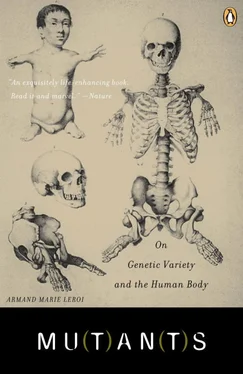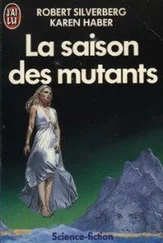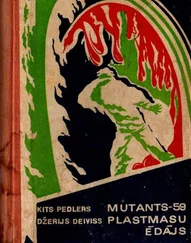South Africa: apartheid 262–4; Cape Malays 137–8, 140; extra-bone mutation 140–1; Huntington disease 298; sclerosteosis 300
Soviet leaders: and balding 281
Spallanzani, Lazzaro 145
Spemann, Hans 37–8, 39–40, 44, 45, 147
spina bifida 51–2, 58
‘split-hand-split-foot’ syndrome 108 , 108–9
SRY (Sex-determining Region on Y) 232–3, 234, 328, 329
Stanislaus, King of Poles 172, 174
Stendhal (Marie Henri Beyle) 219, 356
sterility 240
Strauss, Johann, the Younger 111–12
Sun Yaoting 201
sunlight: and skin 318–19
superoxide dismutases (SODs) 315–16
SOD1 mutations 316–18
Swammerdam, Jan 227
sweat glands 286, 287, 288
Sweden: mortality rates 329, 330, 331
synpolydactyly 128
tadpoles: and retinoic acid 81
Taron/Daru 192, 193 , 193–4, 195, 198
Taverne, M. (Burgomaster) 257–8
teeth 286–7, 288
telomerase 320–2, 323
telomeres 320–1, 322–3
teratology 8, 26
teratomas 54
testes/testicles 202, 203, 222
testosterone 203, 234, 235, 237–8, 239, 244; and baldness 282–4; effects on hyenas 241, 242
thalidomide 118–21
thanatophoric dysplasia 66, 135 , 156–7
Thibaut-Francesco 186–8, 187
thyroid gland 196–7, 198
thyrotropin 197–8
thyroxine 197
Tierra del Fuego: the Selk’nam 347, 348
Times, The 35
Tintoretto, Jacopo: Luigi Cornaro 295 , 310
toes see digits
tongues, over-large 157
toothlessness 286, 287
Toulouse-Lautrec, Henri de 161–5, 163 , 267
transcription factors (molecular switches) 88–9, 95, 125, 126, 140
transforming growth factor-betas (TGFß) 41
Treffan, Comte de 172
Turlepreton 132–3
twins, conjoined 23, 27–35, 29, 45–6, 46 , 48–9, 53–4, 55–6, 60–1; see also Parodi, Ritta and Christina
Twitty, Victor Chandler 144–7, 153
two-toed people 109–10
Tyson, Edward 182–3, 250
ultraviolet light 318–19
United States of America: eugenics programmes 282–3; heights 209, 211–12, 213; presidents 211, 213, 281; skulls 343–4
Unthan, Hermann (‘The Armless Fiddler’) 111–12, 114
vagina, the 223, 224, 224, 225, 229
Verschuer, Otamar, Freiherr von 147, 148
vertebrae, human 91–3, 98
Vesalius, Andreas: De fabrica 223–4, 224, 225
vestibular bulbs 226–7, 227
Victor Emmanuel II, of Italy 187
Vigenère, Blaise de: Les images Philostratus 70
vitamin A 80
Vrolik, Willem: anatomical collection 65, 66–7, 78, 90–1, 156; Tabula …67–8, 72, 73, 119, 119–20, 135 , 156
Wadoma, the 110
Werner’s syndrome 319
Wigtown, Scotland 106, 107, 115
Wilding, Alexa 345
Williams, George 302, 303, 306, 307
Wilson, Margaret 106–7, 108
Winckelmann, Johann Joachim 350
Wright, Sewall 122
wrinkles 318–19
X chromosomes 230, 232, 233
Xiphopages 48
Y chromosomes 230–3
Yanomamo tribe 191
Zhang Deyi 268
‘zone of polarising activity’ (ZPA) 123, 124, 126
Zulu albinos 245 , 254
Frontispiece to Fortunio Liceti 1634 De monstrorum natura caussis et differentiis. (Wellcome Library, London)
The Monster of Ravenna (1512). From Ulisse Aldrovandi 1642 Monstrorum historia. (Wellcome Library, London)
Roberts’s syndrome. Stillborn infant. From B.C. Hirst and G.A. Piersol 1893 Human monstrosities. (Wellcome Library, London)
Conjoined twins: pygopagus. Judith and Hélène (1701–23). From George Leclerc Buffon 1777 Histoire naturelle générale et particulière. (Wellcome Library, London)
Conjoined twins: parapagus dicephalus tetrabrachius. Ritta and Christina Parodi (1829). From Étienne Serres 1832 Recherches d’anatomie transcendante et pathologique. (British Library)
Conjoined twins: parapagus dicephalus dibrachius. Normandy. From Pierre Boaistuau 1560 Histoires prodigieuses. (Wellcome Library, London)
Conjoined twins: parapagus dicephalus dibrachius. From B.C. Hirst and G.A. Piersol 1893 Human monstrosities. (Wellcome Library, London)
Conjoined twins: cephalothoracoileopagus. From Étienne Serres 1832 Recherches d’anatomie transcendante et pathologique. (British Library)
Conjoined twins: situs inversus viscera. Ritta and Christina Parodi. From Étienne Serres 1832 Recherches d’anatomie transcendante et pathologique. (British Library)
Kartagener’s syndrome. Dissected infant showing situs inversus viscera. From George Leclerc Buffon 1777 Histoire naturelle générale et particulière. (Wellcome Library, London)
Cyclopia. Stillborn infant, Firme, Italy (1624). From Fortunio Liceti 1634 De monstrorum natura caussis et differentiis. (Wellcome Library, London)
Cyclops wooing Galatea. From Blaise de Vigenère 1624 Les images Philostratus. (British Library)
Cyclopia with conjoined twinning. Attributed to Leonardo da Vinci. From Fortunio Liceti 1634 De monstrorum natura caussis et differentiis. (Wellcome Library, London)
Cyclopia. Stillborn calf. From Willem Vrolik 1844–49 Tabulae ad illustrandam embryogenesin hominis et mammalium tarn naturalem quam abnormem. (Wellcome Library, London)
Cyclopia. Stillborn infant. From B.C. Hirst and G.A. Piersol 1893 Human monstrosities. (Wellcome Library, London)
Wild type mouse; sonic hedgehog-defective mouse. (Chin Chiang, Vanderbilt Medical Center)
Duplication of face in a pig: ‘Ditto’. (Jill Helms, University of California San Francisco)
Sirenomelia or mermaid syndrome in a stillborn foetus. From B.C. Hirst and G.A. Piersol 1893 Human monstrosities. (Wellcome Library, London)
Supernumerary neck auricles on goat and satyr. Pan Raping a Goat. Roman copy of Hellenistic original, second–third century BC. (Villa dei Papiri in Herculaneum, National Archaeological Museum, Naples. © 2003, Photo Scala, Florence)
Supernumerary auricles. Eight-year-old girl, England 1858. From William Bateson 1894 Materials for the study of variation. (Imperial College London)
Somites in a human embryo. From Franz Keibel 1908 Normentafel zur Entwicklungsgeschichte des Menschen. (Frietson Galis, University of Leiden)
Phocomelia. Skeleton of Marc Cazotte a.k.a. Pepin (1757–1801). From Willem Vrolik 1844–49 Tabulae ad illustrandam embryogenesin hominis et mammalium tarn naturalem quam abnormem. (Wellcome Library, London)
Split-hand-split-foot, or ectrodacytly, or lobster-claw syndrome. Girl with radiograph of mother’s foot, England. From Karl Pearsor 1908 ‘On the inheritance of the deformity known as split-foot or lobster claw’. ( Biometrika 9:330–1. Author’s collection)
Acheiropody. An aleijadinho , Brazil 1970s. (Ademar Freire-Maia, UNESP – Paulista State University)
Phocomelia. Marc Cazotte a.k.a. Pepin (1757–1801). From Willem Vrolik 1844–49 Tabulae ad illustrandam embryogenesin hominis et mammalium tarn naturalem quam abnormem. (Wellcome Library, London)
Mirror-image polydactyly. From William Bateson 1894 Materials for the study of variation. (Imperial College London)
Thanatophoric dysplasia. Stillborn infant, Amsterdam c.1847. From Willem Vrolik 1844–49 Tabulae ad illustrandam embryogenesin hominis et mammalium tarn naturalem quam abnormem. (Wellcome Library, London)
Fibrodysplasia ossificans progressiva. Harry Eastlack (1930–73), USA 1953. (Linda Lindgren, Los Angeles, and Gretchen Worden, Mütter Museum, Philadelphia)
Читать дальше












